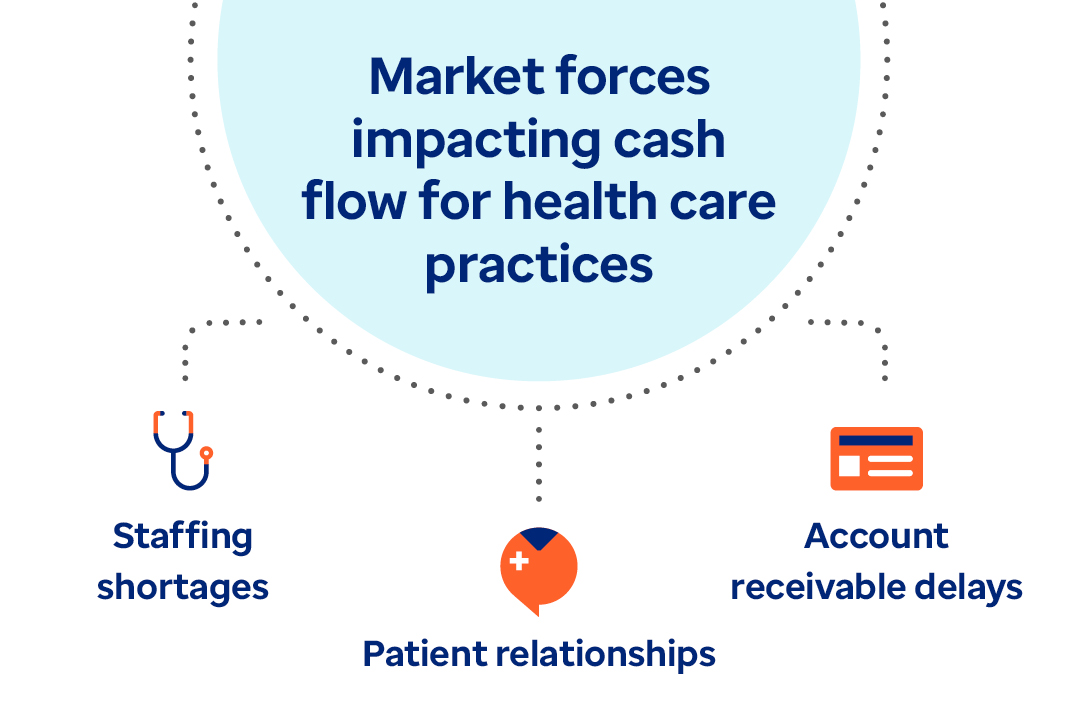Market dynamics are driving the need for payment optimization
It's no secret that the healthcare landscape is evolving quickly. Medical practice staffing shortages are at an all-time high, and the demand for care has risen dramatically. So have costs.
In addition, high-deductible plans and uncertainty about insurance coverage have increased patients' financial responsibility. As a result, more than half of Americans are delaying medical payments, affecting cash flow and operations.
Also, now that many patients want digital tools like virtual care and 24/7 access to their health information, practices need to address shifts in expectations to stay competitive.
Against this backdrop, the findings of a survey by Deloitte — that 49% of health plan executives want more data sharing and collaboration with providers — aren’t surprising.1 Payers and providers are seeking ways to boost efficiency and eliminate payment complexities.
Delivering on these dynamics requires payers to pivot and find innovative ways to address provider needs. That’s where claims payment delivery comes in.
One-fourth of medical claims payments are still fully manual
The movement of money is crucial to making the healthcare system work. Claims payment delivery plays a critical role here, with digital processes far exceeding manual processes in terms of efficiency, effectiveness, payer experience and savings.
In recent years, payers have made great strides toward shifting to digital processes:
- Claims automation is on the rise, and most payments are now electronic
- 67% of health plans are in the process of going paperless2
- 50% of health plans have a strategy to streamline or automate their claims payment system2
But various factors — from resource constraints to resistance to change — keep payment delivery from being a priority. As a result, paper checks still make up 25% of medical claims payments.3 And because they require end-to-end human interaction, the cost is steep.
Administrative simplification could save up to $265B annually
The Council for Affordable Quality Healthcare, Inc. (CAQH) is a nonprofit organization that tracks electronic adoption of administrative functions across the healthcare industry. It offers compelling evidence to shift to fully automated administrative processes.
According to the 2022 CAQH Index, there was a 28% increase in medical administrative transactions over the prior year and a 15% increase in time to conduct transactions.3 Transitioning to electronic payments would save payers $0.48 per claims payment transaction.3
Then consider this. According to a 2021 McKinsey report, 30 known administrative interventions could save U.S. healthcare up to $265 billion annually. Streamlining claims processing and related support functions represents approximately $175 billion of that total.4
Key factors when choosing a payment delivery solution
Given all this, it's imperative that health plans implement a digital strategy for their payment delivery solution. This requires finding a partner with a solution that delivers on multiple fronts — streamlining the payment process, boosting efficiency and accuracy, and lowering administrative costs.
To get started, focus on finding a payment delivery process that aligns the right payment method with provider needs. Look for solutions that:
- Are easily integrated into existing systems
- Offer multiple forms of payment and a track record of increasing electronic adoption; electronic payments have proven ROI by lowering print and postage costs
- Ensure providers of an easy-to-use system with fast, efficient payments in the modality of choice, freeing them to focus on patient care
Market forces impacting cash flow for health care practices
This infographic depicts 3 market forces impacting cash flow for healthcare practices — staffing shortages, patient relationships and accounts receivable delays.


This infographic depicts 3 market forces impacting cash flow for health care practices: staffing shortages, patient relationships and accounts receivable delays.
Related health care insights

Case study
Thinking about going paperless for claims payments? We commissioned a study of senior health plan executives to hear what’s on their minds.

Article
See the critical products our clients use to manage drug spend and improve outcomes.

Article
From tariffs to GLP-1s and AI, see which pharmacy topics led the conversation — and why they still matter going into 2026.
Sources
- Deloitte. Future-proofing the business. May 20, 2021. Accessed November 11, 2022.
- Optum Financial. Insights in Claims Payment Processing, p. 3. Copyright 2023.
- 2022 CAHQ Index. A Decade of Progress. Copyright 2023. Accessed March 14, 2023.
- McKinsey & Company. Administrative simplification: How to save a quarter-trillion dollars in US healthcare. October 2021. Accessed November 11, 2022.
